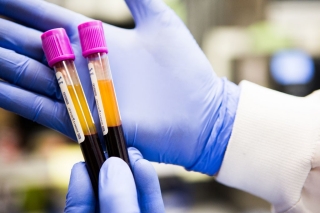A team from Stanford University School of Medicine has created a more affordable, efficient blood test to combat growing antibiotic resistance by providing an easy method to discern between viral and bacterial infections.
Overprescription of antibiotics for infections that are not bacterial has led to a rise in antibiotic-resistant pathogens, rendering doctors helpless to treat patients with illnesses that once could have been easily cured.
“Antimicrobial resistance is not an individual’s problem — it’s a problem for everyone,” said Timothy Sweeney M.S. ’15 Ph.D. ’15, lead author of the paper that the School of Medicine team published earlier this month in Science Translational Medicine. “It doesn’t matter if you’ve personally had antibiotics: the fact is antibiotic resistant bacteria are growing… It’s a policy-level problem.”
Antibiotic resistance is an especially serious problem in third world countries, where antibiotic administration runs rampant because antibiotics are cheaper than the standard infection-categorizing blood test, according to Purvesh Khatri, assistant professor of medicine and of biomedical data science and senior author of the paper.
“One of the things that I keep telling everybody is, if the diagnostic test for bacterial versus viral infection is more expensive than the cost of the antibiotic itself, it is not going to get adopted,” Khatri said. “Our goal is to make it so that it is cost effective, or at least it is easily accessible without too much cost to developing countries.”

A lack of resources to categorize infections leads many physicians to start antibiotics without a clear idea of whether inflammation is due to a viral or bacterial infection. This can be extremely harmful to the patient, according to Sweeney.
Medical experts beyond Stanford agreed.
“We need rapid tests like this [blood test] to improve the clinical outcomes for patients who need [treatment] immediately,” said Paul Kim, who works at the biopharmaceutical company Puma Biotechnology and holds a Ph.D. in pathology. Kim was not involved in developing the test.
Sweeney says the blood test emerged from his time spent in the hospital. While practicing medicine as a surgery resident at Stanford, he was “frustrated” by the lack of a good diagnostic for infections.
Seeking a solution, members of Stanford’s Institute for Immunity, Transplantation and Infection (ITI) — where Sweeney is an engineering research associate — put their existing knowledge of how genes react to different types of infections to use in what Sweeney calls a “dry lab.” A computer algorithm specific to the ITI’s lab allowed the scientists to look for genes that behave similarly during bacterial infections with many different types of patients. The new blood test incorporates the seven genes that they identified.
Khatri says the blood test is undergoing clinical trials and could take two to three years to go public after approval from the Food and Drug Administration (FDA). When it does, Khatri said, the test has the potential to change the medical world.
“Our hope is that [the blood test] will reduce unnecessary antibiotic prescription,” Khatri said. “That is what is increasing the spread of antibiotic resistant bacteria. Our goal is to help clinicians make a better decision as to whether they should prescribe antibiotics or not.”
Contact Shilpa Sajja at 19ssajja ‘at’ castilleja.org and Rebecca Mak at rmakca ‘at’ gmail.com.
